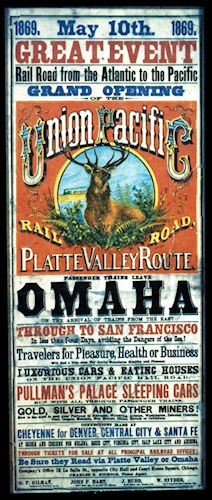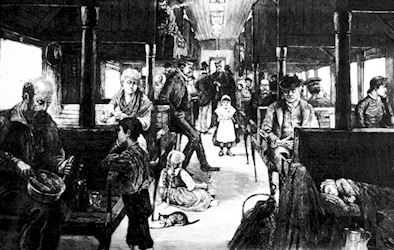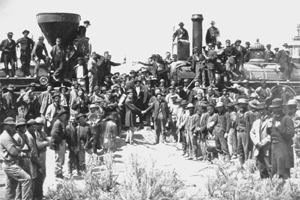The Transcontinental Railroad: Anticipating the WWW
(0) Ground Zero, so to speak: John Sullivan, America's Manifest Destiny, 1845

.... California will, probably, next fall away from the loose adhesion which, in such a country as Mexico, holds a remote province in a slight equivocal kind of dependence on the metropolis. Imbecile and distracted, Mexico never can exert any real governmental authority over such a country. The impotence of the one and the distance of the other, must make the relation one of virtual independence; unless, by stunting the province of all natural growth, and forbidding that immigration which can alone develop its capabilities and fulfil the purposes of its creation, tyranny may retain a military dominion, which is no government in the, legitimate sense of the term. In the case of California this is now impossible. The Anglo-Saxon foot is already on its borders. Already the advance guard of the irresistible army of Anglo-Saxon emigration has begun to pour down upon it, armed with the plough and the rifle, and marking its trail with schools and colleges, courts and representative halls, mills and meeting-houses. A population will soon be in actual occupation of California, over which it will be idle for Mexico to dream of dominion. They will necessarily become independent. All this without agency of our government, without responsibility of our people–in the natural flow of events, the spontaneous working of principles, and the adaptation of the tendencies and wants of the human race to the elemental circumstances in the midst of which they find themselves placed.
--John O’Sullivan, “Annexation,” The United States Magazine and Democratic Review, Volume 17 (New York: 1845), 5-6, 9-10
(1) The Railroad Journey: Traveling in and as a Projectile (or: Bullet Trains of Yesteryear)
"From Ocean to Ocean" - so say the Americans, and these four words ought to be the general name of the "grand trunk," which traverses the United States in their greatest breadth. But, in reality, the Pacific Railroad is divided into two distinct parts; the Central Pacific from San Francisco to Ogden, and the Union Pacific from Ogden to Omaha. . . . New York and San Francisco are therefore now united by an uninterrupted metal ribbon, measuring not less than three thousand seven hundred and eighty-six miles."
– Jules Vernes, Round the World in Eighty Days (chap. 26)

May God continue the unity of our Country as this Railroad unites the two great Oceans of the world
– Engraved on the Golden Spike
What was it the Engines said,
touching, head to head
Facing on a single track
Half a world behind each back?
– Bret Harte
(2) Immigration – Before and After
A light car, drawn by a single horse, gallops up to the front with its load of rails. Two men seize the end of a rail and start forward, the rest of the gang taking hold by twos, until it is clear of the car. They come forward at a run. At the word of command the rail is dropped in its place, right side up with care, while the same process goes on at the other side of the car. Less than thirty seconds to a rail for each gang, and so four rails go down to the minute . . . . Close behind the first gang come the gaugers, spikers, and bolters, and a lively time they make of it. It is a grand 'anvil chorus'... It is played in triple time, three strokes to a spike. There are 10 spikes to a rail, 400 rails to a mile, 1,800 miles to San Francisco--21,000,000 times are those sledges to be swung; 21,000,000 times are they to come down with their sharp punctuation before the great work of modern America is complete.
– Newspaper report in East coast daily
There are no first and second class carriages as with us; but there is a gentleman's car and a ladies' car: the main distinction between which is that in the first, everybody smokes; and in the second, nobody does. As a black man never travels with a white one, there is also a negro car; which is a great blundering clumsy chest, such as Gulliver put to sea in, from the kingdom of Brobdingnag. There is a great deal of jolting, a great deal of noise, a great deal of wall, not much window, a locomotive engine, a shriek, and a bell.
– Charles Dickens, American Notes (1842)

I suppose the reader has some notion of an American railroad-car, that long, narrow, wooden box, like a flat-roofed Noah's ark, with stove and a convenience, one at either end, a passage down the middle, and transverse benches upon either hand. Those destined for emigrants on the Union Pacific are only remarkable for their extreme plainness, nothing but wood entering in any part into their constitution, and for the usual inefficacy of lamps . . . . Civility is the main comfort that you miss. Equality, though conceived very largely in America, does not extend so low down as to an emigrant . . . . Many conductors . . . will hold no communication with an emigrant. I asked a conductor one day at what time the train would stop for dinner; as he made no answer I repeated the question, with a like result; a third time I returned to the charge, and then Jack-in-office looked me coolly in the face for several seconds and then looked ostentatiously away . . . .
– Robert Louis Stevenson, Across the Plains (1892)
(3) The World Wide (Media) Link
Singing my days,
Singing the great achievements of the present,
Singing the strong light work of engineers,
Our modern wonders, (the antique ponderous Seven outvied,)
In the Old World the east the Suez canal,
The New by its mighty railroad spann'd,
The seas inlaid with eloquent wires . . .
– Walt Whitman, "Passage to India"
"D-O-N-E"
– Western Union message (after the last spike of transcontinental railroad had been driven in)

Thomas Hill's painting on display at theMuseum of Railroad History, tells a story of finance and politics,celebrating the captains of industry who promoted the interests of theCentral Pacific Railroad.
– courtesy California State Railroad Museum

Thomas Hill's painting on display at theMuseum of Railroad History, tells a story of finance and politics,celebrating the captains of industry who promoted the interests of theCentral Pacific Railroad.
– courtesy California State Railroad Museum
(4) The Unwritten History of Chinese Labor
Chinese Railroad Workers in North America Project (SPICE)
Chinese Railroad Workers Descendants Association
Chinese Labor and the Iron Road
The Transcontinental Railroad Workers / Asian Americans (2019)
Wyoming town erects new monument to violent, anti-immigrant history (2025)
Plus: Special Broadcast on Mormon Laborers
Useful Sites
- Chinese Railroad Workers in North America Project (SPICE)
- Spike 150
- The Transcontinental Railroad
- History of Railroads and Maps
- Manifest Destiny: Creating An American Identity
- Narrow Gauge Railroads
- Western Railroads, Transcontinental
- From Travel to Tourism
- Steam technology & railroads
- Union Pacific homepage
- "Bring Back the Rails" (NYTBR, 13 Jan 2011)
- Train Travel: The First Transcontinental Railroad
